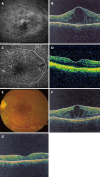Clinical trials on corticosteroids for diabetic macular edema
- PMID: 24379920
- PMCID: PMC3874489
- DOI: 10.4239/wjd.v4.i6.295
Clinical trials on corticosteroids for diabetic macular edema
Abstract
Diabetic macular edema (DME) is a common cause of visual impairment in diabetic patients. It is caused by an increase in the permeability of the perifoveal capillaries and a disruption of the blood retinal-barrier. The pathogenesis of DME is multifactorial. Several therapeutic modalities have been proposed for the treatment of DME. Corticosteroid treatments have emerged as an alternative therapy for persistent DME or refractory to conventional laser photocoagulation and other modalities, due to anti-inflammatory, anti-vascular endothelial growth factor and anti-proliferative effects. Many studies have demonstrated the beneficial therapeutic effect of corticosteroids with improvement to both retinal thickness and visual acuity in short-term on the treatment of DME. Peribulbar and intravitreal injections have been used to deliver steroids for DME with frequent injections due to the chronic and recurrent nature of the disease. Steroid-related side effects include elevated intraocular pressure, cataract, and injection related complications such as endophthalmitis, vitreous hemorrhage, and retinal detachment particularly with intravitreal steroid injections. In order to reduce the risks, complications and frequent dosing of intravitreal steroids, intravitreal implants have been developed recently to provide sustained release of corticosteroids and reduce repeated intravitreal injections for the management of DME.
Keywords: Corticosteroids; Diabetic macular edema; Intravitreal steroid sustained-release implants; Intravitreal triamcinolone acetonide injection; Peribulbar steroid injections; Subtenon’s steroid Injections.
Figures



References
-
- Kaji Y, Usui T, Ishida S, Yamashiro K, Moore TC, Moore J, Yamamoto Y, Yamamoto H, Adamis AP. Inhibition of diabetic leukostasis and blood-retinal barrier breakdown with a soluble form of a receptor for advanced glycation end products. Invest Ophthalmol Vis Sci. 2007;48:858–865. - PubMed
-
- Joussen AM, Poulaki V, Le ML, Koizumi K, Esser C, Janicki H, Schraermeyer U, Kociok N, Fauser S, Kirchhof B, et al. A central role for inflammation in the pathogenesis of diabetic retinopathy. FASEB J. 2004;18:1450–1452. - PubMed
-
- Funatsu H, Yamashita H, Noma H, Mimura T, Yamashita T, Hori S. Increased levels of vascular endothelial growth factor and interleukin-6 in the aqueous humor of diabetics with macular edema. Am J Ophthalmol. 2002;133:70–77. - PubMed
-
- Qaum T, Xu Q, Joussen AM, Clemens MW, Qin W, Miyamoto K, Hassessian H, Wiegand SJ, Rudge J, Yancopoulos GD, et al. VEGF-initiated blood-retinal barrier breakdown in early diabetes. Invest Ophthalmol Vis Sci. 2001;42:2408–2413. - PubMed
-
- Murata T, Ishibashi T, Khalil A, Hata Y, Yoshikawa H, Inomata H. Vascular endothelial growth factor plays a role in hyperpermeability of diabetic retinal vessels. Ophthalmic Res. 1995;27:48–52. - PubMed
Publication types
LinkOut - more resources
Full Text Sources
Other Literature Sources
Medical

